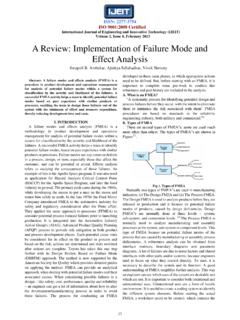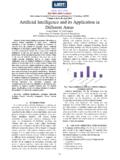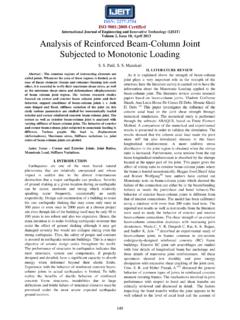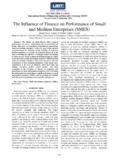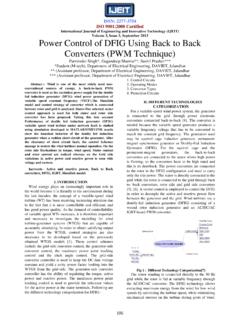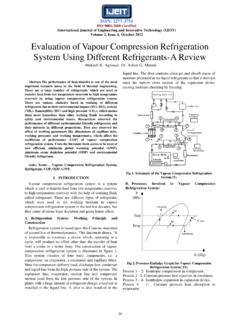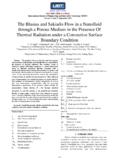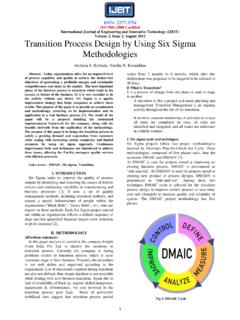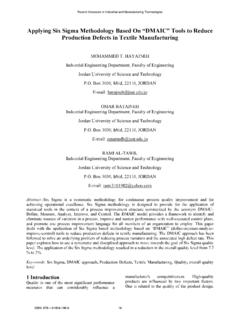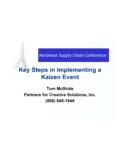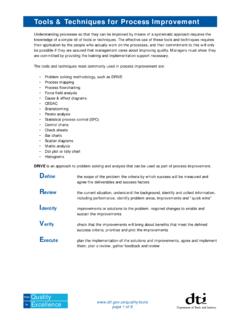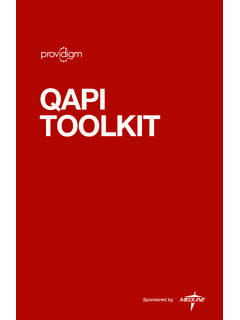Transcription of Volume 5, Issue 11, May 2016 Defect Reduction in an Arc ...
1 ISSN: 2277-3754 ISO 9001:2008 Certified International Journal of Engineering and Innovative Technology (IJEIT) Volume 5, Issue 11, May 2016 28 Abstract Demands are increasing on companies for high quality, reliable products. The increasing capabilities and functionality of many products are making it more difficult for manufacturers to maintain the quality and reliability. The challenge is to design in quality and reliability early in the development cycle. The quality management of manufactured products is one of the main aims in the production process. To make the process more objective rather than relying on the subjective opinion of people, automatic inspection and analysis techniques must be used.
2 Although welding is a straightforward process, metal is a dynamic material, expect many twists and turns along the way. Welding defects can greatly affect weld performance and longevity. Non-Destructive Testing (NDT) techniques have been employed to test a material for surface or internal flaws without interfering in any way with its suitability for service. This paper discusses an effective method to analysis the welding defects using one of the seven quality tool, cause and effect diagram. Index Terms Defect detection, Pareto charts, Defect , Welding, analysis. I. INTRODUCTION Welding is a process of joining of two piece of metal together to form one piece; a strong metallurgical bond is creating between the metals to be joined.
3 Welding is distinguished from other forms of mechanical connections ,such as riveting or bolting which are formed by mechanical interlocking welding is a permanent joining of two piece of material. Welding process is used in large applications of mechanical of manufactured product is one of the main important things in manufacturing process. Welding defects can greatly affect weld performance and longevity. Non-Destructive Testing (NDT) techniques have been employed to test a welded joint for internal or external defects . Commonly using nondestructive testing methods are magnetic particle testing, die penetrant testing and ultrasonic testing in order to identify external or internal Defect . In the present work welded samples are under go nondestructive examination in order to identify the welded defects .
4 Ultrasonic testing, die penetrant testing, magnetic particle inspection methods are used in this work to identify defects are analyzed by using one of the seven quality tool cause and effect diagram. Cause and effect is used to conduct a root cause analysis. In Root Cause Analysis is the process of identifying causal factors using a Structured approach with techniques designed to provide a focus for identifying and resolving problem. A Cause-and-Effect Diagram is a tool that helps identify, sort, and display possible causes of a specific problem or quality It graphically illustrates the relationship between a given outcome and all the factors that influence the outcome. This type of diagram is sometimes called an "Ishikawa diagram" Because it was invented by Kaoru Ishikawa, or a "fishbone diagram" because of the way it looks.
5 II. LITERATURE REVIEW Defect in welding The defects in the weld can be defined as irregularities in the weld metal produced due to incorrect welding parameters or wrong welding procedures or wrong combination of filler metal and parent metal. Different types of welding defects are given below. Crack: Crack may be microscopic scale or macroscopic scale and appear in the base metal, base metal weld metal boundary, or in the weld metal, weld surface or under the weld bead. The main causes of crack are poor ductility of base welding, fast arc travel speed, electrode with high H2 content. Distortion: During welding a good amount of temperature gradient at various points along the joint. Base metal under the arc melts, base metal ahead gets pre heated and base metal portion already welded starts cooling.
6 This phenomena leads to distortion. The various factors leading to distortion are more number of passes with small diameter electrodes, slow arc travel speed and high residual stresses in plates to be welded Incomplete penetration: penetration is the distance from base metal top surface to the maximum extends of the weld nugget. Main reasons are too large root face, less arc current, faster arc travel, longer arc length etc. Inclusions; inclusions may be in the form o slag or any other foreign material, which does not get a chance to float on the surface of the solidifying weld metal and thus gets trapped inside the same. Inclusions lower the strength of the joint and make it weaker. The main reasons are too high or too low arc current, long arcs, too large electrode diameter, too small included angle of joints.
7 Porosity: porosity is a group of small voids, They occur mainly due to the entrapped gases. The parent metal melted under the arc tends to absorb gases like hydrogen, carbon Monoxide, nitrogen and oxygen I they are present around the molten weld metal pool. These gases get spread through the Defect Reduction in an Arc Welding Process Using Cause and Effect Diagram Muhammed Raazick1 Noorshan1, Rashid K1, Rumaisa C M1 Sanmishal P K1, 1 Graduate Student, 2 Assistant Professor Department of Mechanical Engineering, AWH Engineering College Calicut, Kerala, India ISSN: 2277-3754 ISO 9001:2008 Certified International Journal of Engineering and Innovative Technology (IJEIT) Volume 5, Issue 11, May 2016 29 molten metal pool.
8 The solubility of the gases are in the molten metal reduces as it cools, and the dissolve gases escapes through numerous holes in the weld bead called porosity. Main reasons are incorrect welding technique, improper base metal composition etc. Gas holes: Blow holes are large cavities present inside the weld bead, it is also known as gas pockets ,they are bigger isolated holes or is due to gas trapped in the weld metal pool remain in there during solidification. After solidified the space is not filled with weld meal. Spatter: spatter is small metal particles which are thrown out of the arc during welding and get deposited on the base metal around the weld bead along its length. Spatter may be due to excessive arc current, longer arc, electrode being coated with improper flux ingredients etc.
9 Under cutting: In under cutting a groove gets formed in the parent metal along the side of the weld bead. Groove reduces the thickness of the plate and thus the area of the bead, which in turn weakens the weld. The main cause of undercutting is too large electrode diameter, higher current, longer arc, faster arc travel speed. Overlapping: An overlapping occur when the molten metal from electrode flows over the parent metal surface, and remain there without getting properly used and united with the same. Overlapping may occur due to lower arc current, slower arc travel speed, longer arc etc. Poor fusion: the molten metal deposited by the electrodes does not fuse properly with the cold base metal the two do not unite properly and completely. The fusion may be lacking at the root, side, or between two runs in amulti-run is due to poor arc current, faster arc travel, improper weaving technique Non-destructive testing Non-destructive testing method used to identify internal and external defects are visual examination, vibration testing, pressure test, dye penetrant testing, radiographic examination, ultrasonic testing, magnetic particle testing, and eddy current testing.
10 Visual examinations: It consists of checking the surface of casting with eye magnifying lens or low power microscope etc. Vibration test: This test is also known as sound test, percussion test and ring is swing freely and tapping with hammer to set up vibration and certain characteristic tone. Sound produced is listened electronically and compared that o sound of casting. Pressure test: They are used to find out the presents o leak in casting. The casting is immersed in tank carrying water and air pressure is applied, if there is leak bubbles will form. Magnetic particle testing: Magnetic particle inspection is used for alloy and steel, their alloy possessing magnetic property. The casting is first magnetized iron filing are sprinkled in the casting which align in the direction o line o are noticed iron filling jumble around the Defect .
